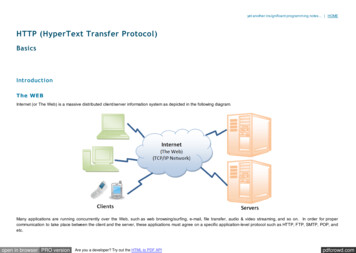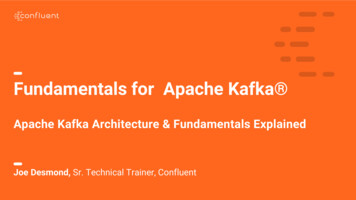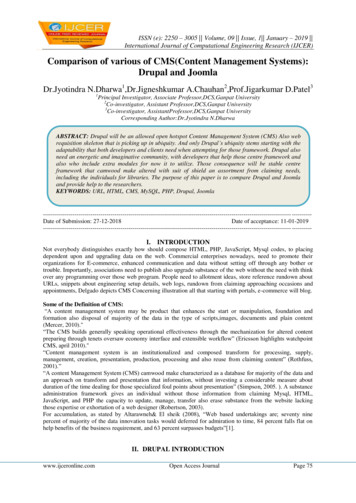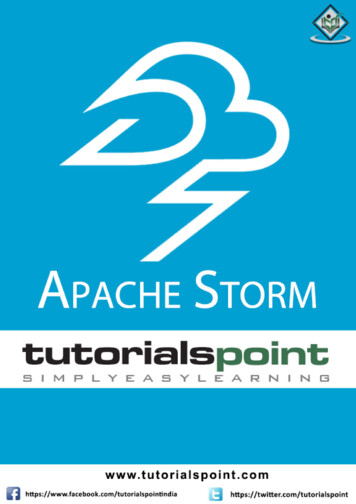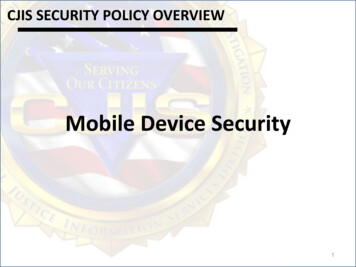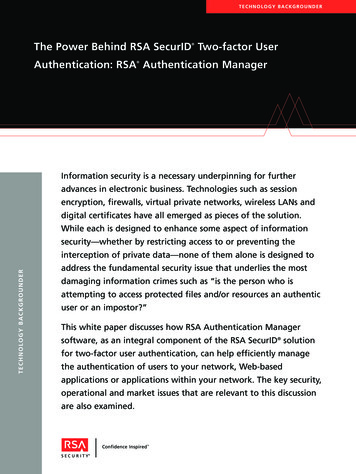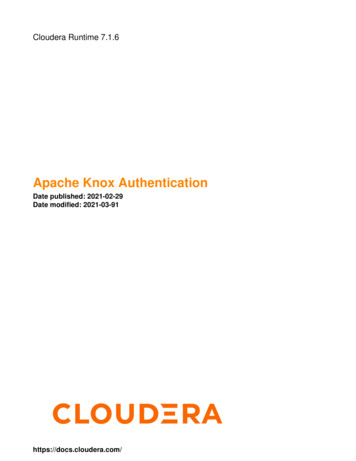
Transcription
Cloudera Runtime 7.1.6Apache Knox AuthenticationDate published: 2021-02-29Date modified: 2021-03-91https://docs.cloudera.com/
Legal Notice Cloudera Inc. 2022. All rights reserved.The documentation is and contains Cloudera proprietary information protected by copyright and other intellectual propertyrights. No license under copyright or any other intellectual property right is granted herein.Unless otherwise noted, scripts and sample code are licensed under the Apache License, Version 2.0.Copyright information for Cloudera software may be found within the documentation accompanying each component in aparticular release.Cloudera software includes software from various open source or other third party projects, and may be released under theApache Software License 2.0 (“ASLv2”), the Affero General Public License version 3 (AGPLv3), or other license terms.Other software included may be released under the terms of alternative open source licenses. Please review the license andnotice files accompanying the software for additional licensing information.Please visit the Cloudera software product page for more information on Cloudera software. For more information onCloudera support services, please visit either the Support or Sales page. Feel free to contact us directly to discuss yourspecific needs.Cloudera reserves the right to change any products at any time, and without notice. Cloudera assumes no responsibility norliability arising from the use of products, except as expressly agreed to in writing by Cloudera.Cloudera, Cloudera Altus, HUE, Impala, Cloudera Impala, and other Cloudera marks are registered or unregisteredtrademarks in the United States and other countries. All other trademarks are the property of their respective owners.Disclaimer: EXCEPT AS EXPRESSLY PROVIDED IN A WRITTEN AGREEMENT WITH CLOUDERA,CLOUDERA DOES NOT MAKE NOR GIVE ANY REPRESENTATION, WARRANTY, NOR COVENANT OFANY KIND, WHETHER EXPRESS OR IMPLIED, IN CONNECTION WITH CLOUDERA TECHNOLOGY ORRELATED SUPPORT PROVIDED IN CONNECTION THEREWITH. CLOUDERA DOES NOT WARRANT THATCLOUDERA PRODUCTS NOR SOFTWARE WILL OPERATE UNINTERRUPTED NOR THAT IT WILL BEFREE FROM DEFECTS NOR ERRORS, THAT IT WILL PROTECT YOUR DATA FROM LOSS, CORRUPTIONNOR UNAVAILABILITY, NOR THAT IT WILL MEET ALL OF CUSTOMER’S BUSINESS REQUIREMENTS.WITHOUT LIMITING THE FOREGOING, AND TO THE MAXIMUM EXTENT PERMITTED BY APPLICABLELAW, CLOUDERA EXPRESSLY DISCLAIMS ANY AND ALL IMPLIED WARRANTIES, INCLUDING, BUT NOTLIMITED TO IMPLIED WARRANTIES OF MERCHANTABILITY, QUALITY, NON-INFRINGEMENT, TITLE, ANDFITNESS FOR A PARTICULAR PURPOSE AND ANY REPRESENTATION, WARRANTY, OR COVENANT BASEDON COURSE OF DEALING OR USAGE IN TRADE.
Cloudera Runtime Contents iiiContentsApache Knox Overview. 4Securing Access to Hadoop Cluster: Apache Knox. 4Apache Knox Gateway Overview.4Knox Supported Services Matrix. 5Knox Topology Management in Cloudera Manager. 6Configuring Apache Knox Gateway UI. 8Proxy Cloudera Manager through Apache Knox. 10Installing Apache Knox.10Apache Knox Install Role Parameters. 12Management of Knox shared providers in Cloudera Manager. 14Configure Apache Knox authentication for PAM. 14Configure Apache Knox authentication for AD/LDAP.15Add a new shared provider configuration. 18Management of existing Apache Knox shared providers. 19Add a new provider in an existing provider configuration.19Modify a provider in an existing provider configuration. 21Disable a provider in an existing provider configuration. 22Saving aliases.24Configuring Kerberos authentication in Apache Knox shared providers. 26Management of services for Apache Knox via Cloudera Manager. 28Enable proxy for a known service in Apache Knox. 29Disable proxy for a known service in Apache Knox. 31Add custom service to existing descriptor in Apache Knox Proxy.32Add a custom descriptor to Apache Knox.34Management of Service Parameters for Apache Knox via ClouderaManager. 35Add custom service parameter to descriptor.35Modify custom service parameter in descriptor.37Remove custom service parameter from descriptor.39
Cloudera RuntimeApache Knox OverviewApache Knox OverviewSecuring Access to Hadoop Cluster: Apache KnoxThe Apache Knox Gateway (“Knox”) is a system to extend the reach of Apache Hadoop services to users outsideof a Hadoop cluster without reducing Hadoop Security. Knox also simplifies Hadoop security for users who accessthe cluster data and execute jobs. The Knox Gateway is designed as a reverse proxy.Establishing user identity with strong authentication is the basis for secure access in Hadoop. Users need to reliablyidentify themselves and then have that identity propagated throughout the Hadoop cluster to access cluster resources.Layers of Defense for a CDP Private Cloud Base Cluster Authentication: Kerberos Cloudera uses Kerberos for authentication. Kerberos is an industry standard used to authenticate users andresources within a Hadoop cluster. CDP also includes Cloudera Manager, which simplifies Kerberos setup,configuration, and maintenance.Perimeter Level Security: Apache Knox Apache Knox Gateway is used to help ensure perimeter security for Cloudera customers. With Knox, enterprisescan confidently extend the Hadoop REST API to new users without Kerberos complexities, while alsomaintaining compliance with enterprise security policies. Knox provides a central gateway for Hadoop RESTAPIs that have varying degrees of authorization, authentication, SSL, and SSO capabilities to enable a singleaccess point for Hadoop.Authorization: RangerOS Security: Data Encryption and HDFSApache Knox Gateway OverviewA conceptual overview of the Apache Knox Gateway, a reverse proxy.OverviewKnox integrates with Identity Management and SSO systems used in enterprises and allows identity from thesesystems be used for access to Hadoop clusters.Knox Gateway provides security for multiple Hadoop clusters, with these advantages: Simplifies access: Extends Hadoop’s REST/HTTP services by encapsulating Kerberos to within the Cluster.Enhances security: Exposes Hadoop’s REST/HTTP services without revealing network details, providing SSL outof the box.Centralized control: Enforces REST API security centrally, routing requests to multiple Hadoop clusters.Enterprise integration: Supports LDAP, Active Directory, SSO, SAML and other authentication systems.Typical Security Flow: Firewall, Routed Through Knox GatewayKnox can be used with both unsecured Hadoop clusters, and Kerberos secured clusters. In an enterprise solution thatemploys Kerberos secured clusters, the Apache Knox Gateway provides an enterprise security solution that: Integrates well with enterprise identity management solutionsProtects the details of the Hadoop cluster deployment (hosts and ports are hidden from end users)Simplifies the number of services with which a client needs to interact4
Cloudera RuntimeApache Knox OverviewKnox Gateway Deployment ArchitectureUsers who access Hadoop externally do so either through Knox, via the Apache REST API, or through the HadoopCLI tools.Knox Supported Services MatrixA support matrix showing which services Apache Knox supports for Proxy and SSO, for both Kerberized and NonKerberized clusters.Table 1: Knox Supported ComponentsComponentUI Proxy (with SSO)API ProxyAtlas API##Atlas UI##Cloudera Manager API##Cloudera Manager UI#Data Analytics Studio (DAS)#BeaconDruidFalconFlinkHBase REST API(aka WebHBase & Stargate)#HBase UI#HDFS UI#HiveServer2 HTTP JDBC API (HS2 viaHTTP)#HiveServer2 LLAP JDBC APIHiveServer2 LLAP UIHiveServer2 UIHue#Impala HTTP JDBC API#Impala UI#JobHistory UI#JobTracker#Kudu UI#Livy API UI##NameNode##NiFi##NiFi Registry##Oozie API##Oozie UI#LogSearchPhoenix (aka Avatica)#5
Cloudera RuntimeApache Knox OverviewComponentUI Proxy (with SSO)API ProxyProfiler#Ranger API#Ranger UI#ResourceManager API##Schema Registry API UI##Streams Messaging Manager (SMM) API##Streams Messaging Manager (SMM) UI#Solr#Spark3History UI#SparkHistory UI###StormStorm LogViewerSupersetWebHCatWebHDFS#YARN UI#YARN UI V2#Zeppelin UI#Zeppelin WS#Note:APIs, UIs, and SSO in the Apache Knox project that are not listed above are considered Community Features.Community Features are developed and tested by the Apache Knox community but are not officiallysupported by Cloudera. These features are excluded for a variety of reasons, including insufficient reliabilityor incomplete test case coverage, declaration of non-production readiness by the community at large, andfeature deviation from Cloudera best practices. Do not use these features in your production environments.Knox Topology Management in Cloudera ManagerIn CDP Private Cloud, you can manage Apache Knox topologies via Cloudera Manager using cdp-proxy andcdp-proxy-api.Shared providersThe Cloudera Manager configurations where the cdp-proxy and cdp-proxy-api topologies can be managedare: Knox Simplified Topology Management - cdp-proxyKnox Simplified Topology Management - cdp-proxy-api6
Cloudera Runtime Apache Knox OverviewThe SSO authentication provider is used by the UIs using the Knox SSO capabilities, such as the Admin andHome Page UIs.The API authentication provider is used by predefined topologies, such as admin, metadata or cdp-proxyapi.You can add or modify new or existing shared provider configurations.You can save aliases using a new Knox Gateway command.ServicesYou can enable or disable known or custom services in Knox proxy via Cloudera Manager.There are two kinds of services in cdp-proxy: Known: officially-supported Knox services. Cloudera Manager provides and manages all the required servicedefinition files.Custom: unofficial, tech preview, or community feature Knox services. You must supply the service definitionfiles (service.xml and rewrite.xml) that exist in the KNOX DATA DIR/services folder. These arenot recommended for production environments, and not supported by Cloudera.Important:These topologies will be deployed by Cloudera Manager only if Knox’s service auto-discovery feature isturned on using the Enable/Disable Service Auto-Discovery checkbox on Cloudera Manager UI:Important: Adding a custom service will only work if you provide the service definition files (service.xml and rewrite.xml) in the KNOX DATA DIR/services folder.Service parametersYou can add, modify, or remove custom service parameters in Knox proxy via Cloudera Manager.7
Cloudera RuntimeConfiguring Apache Knox Gateway UIConfiguring Apache Knox Gateway UIKnox Proxy can be configured using the Knox Gateway UI. To set up proxy, you will first define the providerconfigurations and descriptors, and the topologies will be automatically generated based on those settings.Before you beginWhen logging into the Gateway UI, Knox is expecting a user that can log into the operating system.About this taskCloudera Manager creates the majority of the topologies you need. You can use the Knox Gateway UI to createadditional topologies or modify existing ones.The following steps show the basic workflow for how to set up Knox Proxy. It involves defining providerconfigurations and descriptors, which are used to generate your topologies, which can define proxy (among otherthings). You can also manually set up Knox Proxy by manually configuring individual topology files.Before you begin Cloudera Manager must be installed.Procedure1. Navigate from Cloudera Manager to the Knox Gateway UI: Cloudera Manager Clusters Knox KnoxGateway Home General Proxy Information Admin UI URL.The Knox Gateway UI opens, e.g. manager/admin-ui.2. Login to the Gateway UI.8
Cloudera RuntimeConfiguring Apache Knox Gateway UI3. Create a Provider Configuration:a) From the Gateway UI homepage, click Provider Configurations .The Create a New Provider Configuration wizard opens.b) Name the provider configuration: for example, CDP ui provider.c) Add an Authentication provider:1. Click Add Provider.2. Select Authentication and click Next.3. Choose your Authentication Provider Type: LDAP, PAM, Kerberos, SSO (HeaderPreAuth), SSOCookie (SSOCookieProvider), JSON Web Tokens (JWT), CAS, OAuth, SAML, OpenID Connect,Anonymous.Note: OAuth, OpenID Connect, and CAS are community supported, they are not officially supported byCloudera.4. Complete the required fields and click OK.d) Add an Authorization provider:1. Click Add Provider.2. Select Authorization and click Next.3. Click Access Control Lists.4. Fill out the required fields and click OK.e) Add an Identity Assertion provider:1. Click Add Provider.2. Select Identity Assertion and click Next.3. Choose a Identity Assertion Provider Type: Default, Concatenation, SwitchCase, Regular Expression,Hadoop Group Lookup (LDAP).Recommended: Default.4. Fill out the required fields and click OK.f) Add an HA provider:1. Click Add Provider.2. Select HA and click Next.3. Select Add Service and click Next.4. Fill out the required fields and click OK.4. Define Descriptors for the topology to auto-discover services.a) Create a new descriptor. From the Gateway UI homepage, click Descriptors .b) Name the descriptor.c) Beside the Provider Configuration field, click the edit button and select the Provider Configuration youcreated before.d) Add Services (e.g., JOBTRACKER, HIVE, HDFSUI, STORM) by clicking the checkbox beside the service.If the service you are looking for is not listed, you can add it later by editing the configuration (the plus iconnext to services will present a text box.)e) Add Discovery details:FieldExample 80ClusterdwweeklyUsernameadminPassword aliasdiscovery-passwordf) Click OK.9
Cloudera RuntimeProxy Cloudera Manager through Apache KnoxWhat to do nextVerify the topology was generated correctly. You can review the XML topology file for accuracy from Gateway UIhomepage Topologies topology name, e.g. devcluster .Proxy Cloudera Manager through Apache KnoxIn order to have Cloudera Manager proxied through Knox, there are some steps you must complete.Procedure1. Set the value for frontend url: Cloudera Manager Administration Settings Cloudera ManagerFrontend URL: Non-HA value: https:// Knox host: knox port HA value: https:// Knox loadbalancer host: Knox loadbalancer port2. Set allowed groups, hosts, and users for Knox Proxy: Cloudera Manager Administration Settings External Authentication: Allowed Groups for Knox Proxy: * Allowed Hosts for Knox Proxy: * Allowed Users for Knox Proxy: *3. Enable Kerberos/SPNEGO authentication for the Admin Console and API: Cloudera Manager Administration Settings External Authentication Enable SPNEGO/Kerberos Authentication for theAdmin Console and API:: true4. From Cloudera Manager Administration Settings External Authentication, set Knox Proxy Principal:knox.What to do nextExternal authentication must be set up correctly. Cloudera Manager must be configured to use LDAP, following thestandard procedure for setting up LDAP. This LDAP server should be the same LDAP that populates local users onKnox hosts (if using PAM authentication with Knox), or the same LDAP that Knox is configured to use (if usingLDAP authentication with Knox).Installing Apache KnoxThis document provides instructions on how to install Apache Knox using the installation process.About this taskApache Knox is an application gateway for interacting with the REST APIs and UIs. The Knox Gateway provides asingle access point for all REST and HTTP interactions in your Cloudera Data Platform cluster.Before you beginWhen installing Knox, you must have Kerberos enabled on your cluster.10
Cloudera RuntimeInstalling Apache KnoxProcedure1. From your Cloudera Manager homepage, go to Status tab Cluster Name . Add Service2. From the list of services, select Knox and click Continue.3. On the Select Dependencies page, choose the dependencies you want Knox to set up:HDFS, Ranger, Solr, ZookeeperFor users that require Apache Ranger for authorization.HDFS with Ranger. HDFS depends on Zookeeper, andRanger depends on Solr.HDFS, ZookeeperHDFS depends on Zookeeper.No optional dependenciesFor users that do not wish to have Knox integrate withHDFS or Ranger.4. On the Assign Roles page, select role assignments for your dependencies and click Continue:Knox service rolesDescriptionRequired?Knox GatewayIf Knox is installed, at least one instanceRequiredof this role should be installed. This rolerepresents the Knox Gateway which providesa single access point for all REST and HTTPinteractions with Apache Hadoop clusters.11
Cloudera RuntimeInstalling Apache KnoxKnox service rolesDescriptionRequired?KnoxIDBroker*It is strongly recommended that this role isinstalled on its own dedicated host. As itsname suggests this role will allow you totake advantage of Knox’s Identity Brokercapabilities, an identity federation solutionthat exchanges cluster authentication fortemporary cloud credentials.*Optional*GatewayThis role comes with the CSD framework.The gateway structure is used to describe theclient configuration of the service on eachhost where the gateway role is installed.Optional* Note: KnoxIDBroker appears in the Assign Roles page, but it is not currently supported in CDP Private Cloud.5. On the Review Changes page, most of the default values are acceptable, but you must Enable KerberosAuthentication and supply the Knox Master Secret. There are additional parameters you can specify or change,listed in “Knox Install Role Parameters”.a) Click Enable Kerberos AuthenticationKerberos is required where Knox is enabled.b) Supply the Knox Master Secret, e.g. knoxsecret.c) Click Continue.6. The Command Details page shows the status of your operation. After completion, your system admin can viewlogs for your installation under stdout.Apache Knox Install Role ParametersReference information on all the parameters available for Knox service roles.Service-level parametersTable 2: Required service-level parametersNameIn WizardTypeDefault Valuekerberos.auth.enabled*YesBooleanfalseranger knox plugin hdfs audit directoryNoText {ranger base audit url}/knoxautorestart on stopNoBooleanfalseknox pam realm serviceNoTextloginsave alias command input passwordNoText-Knox Gateway role parametersTable 3: Required parameters for Knox Gateway roleNameIn WizardTypeDefault Valuegateway master secretYesPassword-gateway conf dirYesPath/var/lib/knox/gateway/confgateway data dirYesPath/var/lib/knox/gateway/datagateway portNoPort8443gateway pathNoTextgateway12
Cloudera RuntimeInstalling Apache KnoxNameIn WizardTypeDefault Valuegateway heap sizeNoMemory1 GB (min 256 MB; soft min 512MB)gateway ranger knox plugin conf pathNoPath/var/lib/knox/ranger-knox-plugingateway ranger knox plugin policy cache cachegateway ranger knox plugin hdfs audit spool oolgateway ranger knox plugin solr audit spool oolNameTypeDefault Valuegateway default topology nameTextcdp-proxygateway auto discovery enabledBooleantruegateway cluster configuration monitor intervalTime60 seconds (minimum 30 seconds)gateway auto discovery advanced configuration monitor intervalTime10 seconds (minimum 5 seconds)gateway cloudera manager descriptors monitor intervalTime10 seconds (minimum 5 seconds)gateway auto discovery cdp proxy enabled *Booleantruegateway auto discovery cdp proxy api enabled *Booleantruegateway descriptor cdp proxyText ArrayContains the required properties of cdpproxy topologygateway descriptor cdp proxy apiText ArrayContains the required properties of cdpproxy-api topologygateway sso authentication providerText ArrayContains the required properties of theauthentication provider used by theUIs using the Knox SSO capabilities(Admin UI and Home Page). Defaultsto PAM authentication.gateway api authentication providerText ArrayContains the required properties ofthe authentication provider used bypre-defined topologies such as admin,metadata or cdp-proxy-api. Defaults toPAM authentication.Table 4: Optional parameters for Knox Gateway roleKnox IDBroker role parametersNote: Knox IDBroker is not currently supported in CDP Private Cloud.Table 5: Required parameters for Knox IDBroker roleNameIn WizardTypeDefault Valueidbroker master secretYesPassword-idbroker conf dirYesPath/var/lib/knox/idbroker/confidbroker data dirYesPath/var/lib/knox/idbroker/dataidbroker gateway portNoPort8444idbroker gateway pathNoTextgateway13
Cloudera RuntimeManagement of Knox shared providers in Cloudera ManagerNameIn WizardTypeDefault Valueidbroker heap sizeNoMemory1 GB (min 256 MB; soft min 512 MB)Table 6: Optional parameters for Knox IDBroker roleNameTypeDefault Valueidbroker aws user mappingText-idbroker aws group mappingText-idbroker aws user default group mappingText-idbroker aws credentials keyPassword-idbroker aws credentials secretPassword-idbroker gcp user mappingText-idbroker gcp group mappingText-idbroker gcp user default group mappingText-idbroker gcp credential keyPassword-idbroker gcp credential secretPassword-idbroker azure user mappingText-idbroker azure group mappingText-idbroker azure user default group mappingText-idbroker azure adls2 tenant nameText-idbroker azure vm assumer identityText-idbroker relaodable refresh interval msTime10 seconds (minimum 1 second)idbroker kerberos dt proxyuser blockText ArrayA comma-separated list of proxyuser configuration used in Knox's dttopology in case Kerberos is enabledidbroker knox token ttl msTime1 hour (minimum 1 second)Management of Knox shared providers in ClouderaManagerInformation on CDP Private Cloud topology management for Knox from within Cloudera Manager. Modifying the SSO authentication provider used by the UIs using the Knox SSO capabilities, such as the Adminand Home Page UIs.Modifying the API authentication provider used by predefined topologies, such as admin, metadata or cdpproxy-api.Adding/modifying new/existing shared provider configurations.Saving aliases using a new Knox Gateway command.Configure Apache Knox authentication for PAMKnox authentication configurations for PAM in Cloudera Manager. PAM is the default SSO authentication providerin CDP Private Cloud.14
Cloudera RuntimeManagement of Knox shared providers in Cloudera ManagerSSO authentication for PAMIn CDP Private Cloud, Cloudera Manager added a new Knox configuration, called KnoxSimplified Topology Management - SSO Authentication Provider, with the following initial configuration:role authenticationauthentication.name ShiroProviderauthentication.param.sessionTimeout 30authentication.param.redirectToUrl / {GATEWAY ram.restrictedCookies ls./** authcBasicauthentication.param.main.pamRealm hentication.param.main.pamRealm.service loginEvery change here goes directly into knoxsso topology that affects manager, homepage and cdp-proxytopologies as they are using the federation provider.API authentication for PAMA new Knox configuration has been added for CDP Private Cloud, called Knox Simplified Topology Management - API Authentication Provider, with the following initial configuration:role authenticationauthentication.name ShiroProviderauthentication.param.sessionTimeout 30authentication.param.urls./** authcBasicauthentication.param.main.pamRealm hentication.param.main.pamRealm.service loginEvery change here goes directly into admin, metadata, andcdp-proxy-api topologies.Configure Apache Knox authentication for AD/LDAPKnox authentication configurations for LDAP and AD in Cloudera Manager.15
Cloudera RuntimeManagement of Knox shared providers in Cloudera ManagerSSO authentication for AD/LDAPIn the following sample you will see how to change the PAM authentication (which comes default with Knox) toLDAP authentication. It is as simple as removing the default PAM related configuration in ShiroProvider and addLDAP related properties (e.g. with demo LDAP server configuration):role authenticationauthentication.name ShiroProviderauthentication.param.sessionTimeout 30authentication.param.redirectToUrl / {GATEWAY ram.restrictedCookies ls./** authcBasicauthentication.param.main.ldapRealm thentication.param.main.ldapContextFactory Factory alm.contextFactory.authenticationMechanism actory.url apRealm.contextFactory.systemUsername uid guest,ou people,dc hadoop,dc apache,dc ory.systemPassword {ALIAS dapRealm.userDnTemplate uid {0},ou people,dc hadoop,dc apache,dc orgauthentication.param.remove main.pamRealmauthentication.param.remove main.pamRealm.serviceAfter you finished editing the properties you have to save the configuration changes. This will make the RefreshNeeded stale configuration indicator appear. Once the cluster refresh finishes, all topologies that are configured touse Knox SSO will be authenticated by the configured LDAP server.16
Cloudera RuntimeManagement of Knox shared providers in Cloudera ManagerNote:As you can see we used a Knox alias when we declared the system password instead of writing the plain textpassword there. To make it easier for the end-users a new Knox Gateway command was created that allowsthem to save aliases on all hosts where a Knox Gateway is running. See Saving aliases.To verify: curl -ku knoxui:knoxui dmin/api/v1/providerconfig/knoxsso'.}, {"role" : "authentication","name" : "ShiroProvider","enabled" : true,"params" : {"main.ldapContextFactory" : tFactory","main.ldapRealm" : m","main.ldapRealm.contextFactory" : " .authenticationMechanism" : word" : " {ALIAS ctory.systemUsername" : "uid guest,ou people,dc hadoop,dc apache,dc org","main.ldapRealm.contextFactory.url" : plate" : "uid {0},ou people,dc hadoop,dc apache,dc org","redirectToUrl" : "/ {GATEWAY ies" : "rememberme,WWW-Authenticate","sessionTimeout" : "30","urls./**" : "authcBasic"}Note: Any change in SSO authentication configuration alters the Knox SSO topology. This affects themanager, homepage, and cdp-proxy topologies because the SSO cookie federation provider is used.API authentication for AD/LDAPIn the following sample you will see how to change the PAM authentication (which comes default with Knox) toLDAP authentication:role authenticationauthentication.name ShiroProviderauthentication.param.sessionTimeout 30authentication.param.urls./** authcBasicauthentication.param.main.ldapRealm thentication.param.main.ldapContextFactory Factoryauthentication.param.m
Cloudera Runtime Apache Knox Overview The SSO authentication provider is used by the UIs using the Knox SSO capabilities, such as the Admin and Home Page UIs. The API authentication provider is used by predefined topologies, such as admin, metadata or cdp-proxy-api. You can add or modify new or existing shared provider configurations.

